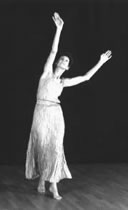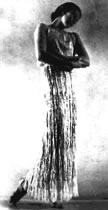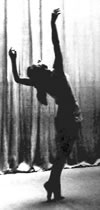| |
>SOLOS
AVAILABLE FOR STAGING
Bodak,
Suzanne (after François Malkovsky)

About
Malkovsky’s Free Dance
by Suzanne Bodak and Karin Hermes-Sunke
The choreographies notated here were created between 1920 and
1946. They were interpreted by Malkovsky or his dancers on Paris stages
between the wars.
The works reflect the gravity and the joy of life. They are dances
of outpouring and abandon, plenitude and emptiness. As they develop,
they are coloured by the palette of tensions, without ever going to
extremes. The movement follows the lines of a unified body, and the
dance flows smoothly, simply, self-evidently. In complete osmosis
with the music, the flow of the movement is punctuated by slight accents
to suspend it elastically in the instability of the imminent imbalance.
It is up to performers to find the harmonies between this dance dream
and bodily experience, in order to embody it and breathe new life
into it.
|
|

Photograph
provided by Suzanne Bodak
|
Formal perfection
is achieved through a "free body." Freedom and fluidity allow
the energy to diffuse through space with presence and awareness: "Free
yourselves from your bonds." In the "Free Dance" style,
it is essential to find what initiates the movement, the internal flow,
and the motivation behind the movement.
All the solos can be performed by either a man or a woman. The
pieces are simple (exept "Grande Valse Brillante" and "Slavonic
Dance") but require a mature performer.
Consultancy is not required, but warmly suggested, for classroom use.
Restagers and dancers are advised to read about Malkovsky’s theory
and background and study the basic movements before learning the choreographies.
Consultancy is required before a public performance. Consultancy
is possible by personal coaching, but in situations where the restaging
is far abroad, we suggest sending a video to begin discussions.
None of the music requires permission. A professional piano recording
made especially for these dances is available at the DNB.

|
 Lullaby
(1922) Lullaby
(1922)
Music: Grieg,
Lyrical Pieces: Book II, Op. 38, No. 1
Length: 3 minutes, 11 seconds
Notation: 1997, published
Costume: Long, off-white silk tunic with cord at waist
"The
gestures are fundamental movements from everyday life. They are
very subdued. The dance does not represent the love of one person
for one's child, it is the quintessence of 'universal maternal
love' and draws from the fund of archetypal motherly gestures."
-Suzanne Bodak, Living Heritage: François Malkovsky's
Free Dance
 5th Mazurka (1923)
5th Mazurka (1923)
Music: Chopin,
Op. 7, No. 1
Length: 1
minute, 45 seconds
Notation:
1998, published
Costume: Black trousers, oriental shirt, and orange belt,
or short silk tunic
|

"Lullaby"
Photograph provided by Suzanne Bodak
|
"From
the sixties onward when Malkovsky performed this mazurka in his studio
for his students, he spoke of a 'call to freedom,' 'fight,' or 'liberty,'
but the choreographer was also inspired by a folkloric theme: a game
of seduction, with a flower in one's hand."
-Suzanne Bodak, Living Heritage: François Malkovsky's Free
Dance
 Constant Thought (1923-24)
Constant Thought (1923-24)
Music:
Brahms, Waltz Op. 39 No. 15
Length: 1 minute, 12 seconds
Notation: 1998, published
Costume: Long, white silk tunic
"'Constant
Thought' by Malkovsky is a tribute to Isadora Duncan. Isadora performed
the waltz with rose petals that she would let fall from her hands, following
the musical phrases. ... Although the movements he imagined recall the
scattering of petals, the choreography is by no means a replication
of Isadora's dance. It is the expression of a spiritual filiation. Malkovsky
said of Isadora: 'She made me understand what I had to seek.'"
-Suzanne Bodak, Living Heritage: François Malkovsky's Free
Dance
|
 |
| |
|
 Slavonic Dance [often called "Joy"] (1925)
Slavonic Dance [often called "Joy"] (1925)
Music: Dvorak,
Op. 46, No. 8
Length: 2 minutes, 30 seconds
Notation: 1998, published
Costume: Short, white silk tunic
"The dance
does not tell a story; it is Malkovsky's most abstract choreogrpahy.
The gestural motifs are coloured by the shades of tensions to
cover the range of nuances joy may take on. A dance of the unfolding
body, it expresses self-fulfillment and relaxation, self-giving
and abandon."
-Suzanne
Bodak, Living Heritage: François Malkovsky's Free Dance
 Little Shepherd (1925)
Little Shepherd (1925)
Music: Debussy,
excerpt from Children's Corner
Length: 2
minutes, 12 seconds
Notation:
1998, published
Costume: Short, off-white silk tunic
|

"Joy"
Photograph provided by Suzanne Bodak
|
"The dance
tells a rather poetic, pastoral story. On a warm afternoon, a young shepherd
is playing the flute in the shade of some trees; he feels in harmony with
nature, sees some friencs, tries to catch their attention, but they don't
respond. Never mind, nature brings him serenity. Evening comes, he rests."
-Suzanne
Bodak, Living Heritage: François Malkovsky's Free Dance
 Morning Song (1925)
Morning Song (1925)
Music: Chopin,
Waltz Op. 70, No. 1
Length: 1 minute,
48 seconds
Notation:
1998, published
"After 1948, Malkovsky
always quoted the same phrase taken from 'Gardener of Love' by Tagore
in order to evoke the atmosphere of the choreography: 'I've lost my
drop of dew, cries the flower to the morning sky, which has lost all
its stars.' Two themes predominate: one is that of joyful, careless
pleasure, the other a sentimental cantilena of gentle langour."
-Suzanne
Bodak, Living Heritage: François Malkovsky's Free Dance
|
 |
| |
 Desire (1931)
Desire (1931)
Music: Beethoven,
Waltz in A flat major
Length: 2
minutes, 22 seconds
Notation: 1997,
published
Costume:
Long, light, white silk tunic
"Malkovsky shed
light on the choreography by quoting a sentence by Rabindranath Tagore:
'Is it my soul which is trying to burst free/Or the soul of the world
which is knocking at my heart to get in.'"
-Suzanne
Bodak, Living Heritage: François Malkovsky's Free Dance
 Grande Valse Brillante (ca. 1936)
Grande Valse Brillante (ca. 1936)
Music: Chopin,
Op. 18
Length:
5
minutes, 43 seconds
Notation: 1998, published
Costume: Short silk tunic
"To perform
it, you must be able to 'organize' your energy in order to give
it out from next to nothing to the utmost, imperceptibly, inevitably.
It is a dance leading to a dead end, you are taken into a whirlwind
which can only end up in a fall. You can hardly breathe. It
is nothing but suspension, suggestion, and leads to extremes."
-Chantal Sentis, quoted in Living
Heritage: François Malkovsky's Free Dance, by Suzanne
Bodak
 Prelude (1946)
Prelude (1946)
Music: Chopin,
Op. 28, No. 7
Length: 57 seconds
Notation: 1998, published
Costume: Long, white silk tunic
|

"Grande
Valse Brillante"
Photograph provided by Suzanne Bodak
|
"The 16 bars are
a dance of pain, with no echo. It is not the suffering of any specific
person, but rather grief itself. The answer lies within ourselves."
-Suzanne
Bodak, Living Heritage: François Malkovsky's Free Dance
|
 |